As you’ve likely encountered on an evening out with friends there’s a specific glass for red wine and a different glass for white wine – but not many people know that beyond cultural aspects, the original intent of the glass shape was designed to enhance the flavours unique to specific red and white wines.
When we began looking for research material in the coffee industry on how a cup may influence the flavour of coffee, to my surprise there was nearly no prior research that we could find. The closest we could find was the extensive research conducted with spirits, beer, and wine. The most notable was the history of the Riedel Wine Glass Company, largely considered to be the pioneer of the wine glass shapes we’ve become so accustomed to. We began our deep dive into the world of wine glass shapes and accumulated countless hours of videos and articles that discussed this topic.
Our journey brought us to meet with wine sommeliers and even visit the Riedel Wine bar in Bangkok where we tried as many glass shapes as we could (our wallets were lighter after that experience). As much progress as we were making in understanding the world of wine, we were challenged with another problem: how can we apply this knowledge of wine and spirits glass shapes to coffee?
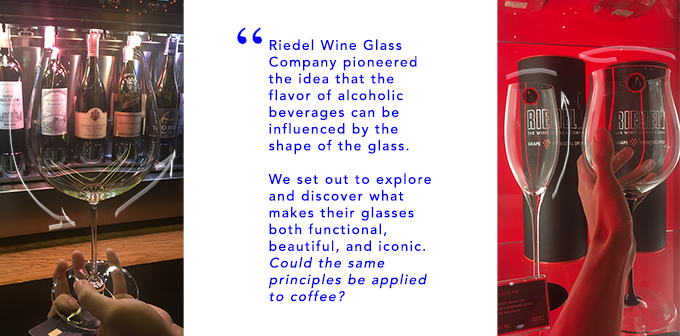
Nothing quite teaches as well as practical, hands-on experience, so we took a trip to the nearest local kitchen supply store and literally purchased every wine and spirits glass that we could get our hands on–from the wide fish bowl montrachet wine glasses, to the narrow champagne flutes. We began experimenting by measuring every aspect of each cup and then tasting coffee in the various shapes. We definitely noticed a difference in aroma and taste, but there was so much variation between each glass that we couldn’t pinpoint what exactly was happening.
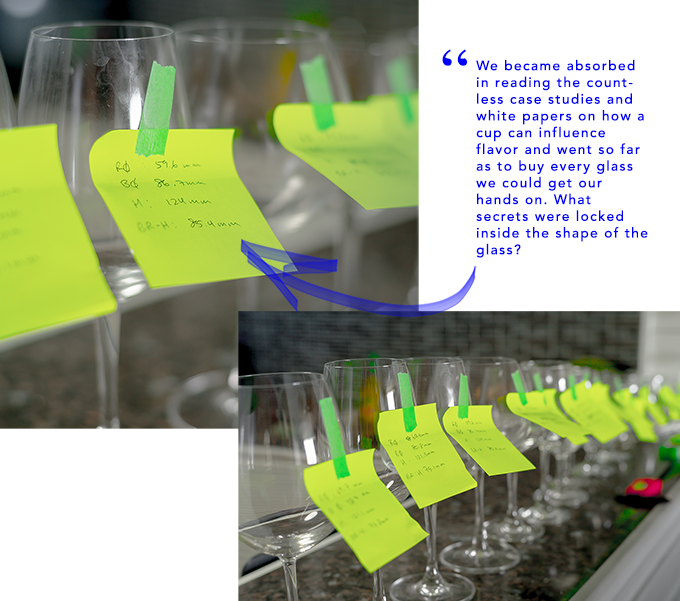
Diving into the science behind the perfect cup
We decided to use our engineering background to create a scientific model to find a way to attribute the characteristics of shape to the different elements of flavor. After weeks of experimenting and creating mathematical models and even consulting with renowned coffee scientists, we were completely stumped. If a cup was taller and wider, would it make the coffee sweeter? If a cup had a narrower opening that flared outwards, would it make the coffee more acidic? We couldn’t predict how the individual variables would influence the outcome; there were simply too many variables that changed between each cup to accurately attribute a specific enhancement of flavor to a specific shape element.
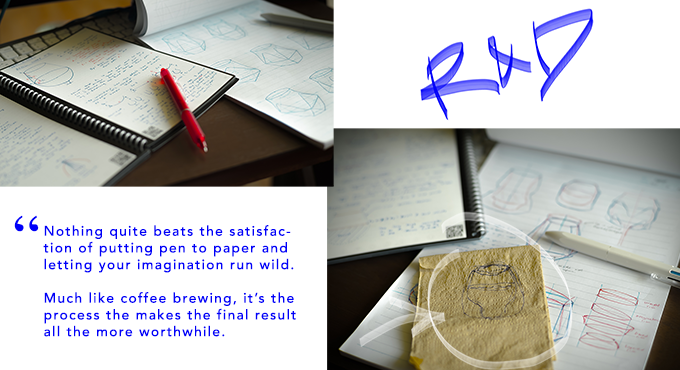
The Science of Wine & Spirits – Can it Work for Coffee Too?
To answer that big question we decided to conduct our very first experiment on flavor and call on the help of a professional. Through our friend Tim from Coffee Geek, we got connected with a coffee expert and new friend Luke, from &Bloss Roasting Company, and together we created an experiment of our own. We brought all of those wine and spirits glasses to Luke’s lab to brew up his favorite coffee and taste test from as many glasses as possible.
Our BIG Experiment Breakthrough

As an experienced international coffee trainer, direct-trade roaster, and Q-grader, Luke has a seasoned sense of taste and smell; he can detect the slightest change in a coffee’s flavor. The goal in this experiment was to have him try the same coffee in the different glasses to understand how the differences in glass shape can alter and enhance the flavor profile of a single coffee.
Luke had never conducted an experiment like this before and he was astonished by the results–every cup changed the flavor of the coffee by varying degrees. Even a subtle flare of the rim would impact the flavor of the coffee.
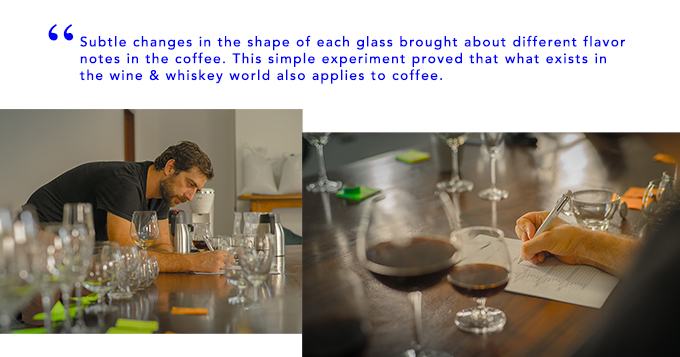
The experiment yielded exciting results, and we had our big breakthrough. As they say ‘the proof is in the pudding’, and in conducting this experiment we had our first proof of concept that this idea could very well change the coffee world.
This breakthrough was a real demonstration that the principles of engineering and architecture that have been used by wine & spirit glass makers for decades also applies to coffee!
Curious to test this for yourself at home? All you need is a few different shaped wine, spirit, or beer glasses and one of your favorite coffee mugs. Brew up enough coffee to pour into each of the glasses and taste from each glass. If you’re still developing your palate, you’ll notice changes in high level flavor aspects like bitterness and acidity, and if you’re a more advanced coffee dinker you’ll notice distinct changes in the flavor characteristics of your coffee (from aromatic notes to specific flavor notes being revealed.).
When Experimentation doesn’t give you all the Answers
After conducting this fun experiment with Luke, there was still one lingering question: how can we attribute each of the elements of the cup’s shape (rim size, cup height, diameter, etc) to a specific enhancement in the coffee’s flavor profile?
If you recall from your science high school experiments, you’ll remember that to measure an outcome/result, all variables have to be held constant while one chosen variable is incrementally altered. By doing this, any change in the outcome can be attributed to the changing variable, and the results can be reproduced by any third party. Well if you consider this principle, our experiment was a complete mess because every cup was completely different from the next! We couldn’t attribute the changes in flavor to any particular variable in the shape of the glass.
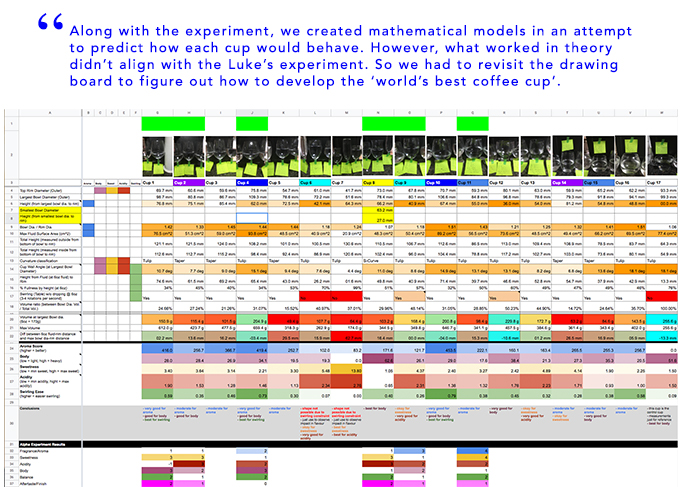
To design the ‘world’s best coffee cup’ we had to truly understand how the cup shape affects the flavor. We couldn’t just guess what was happening, nor could we simply copy something that already existed in the wine and spirits world. To take our experiment to the next level, we went back to the lab and planned how we could create our first line of prototypes. Follow the next step in our journey to design and develop our first prototypes in our next blog post!

No Comments